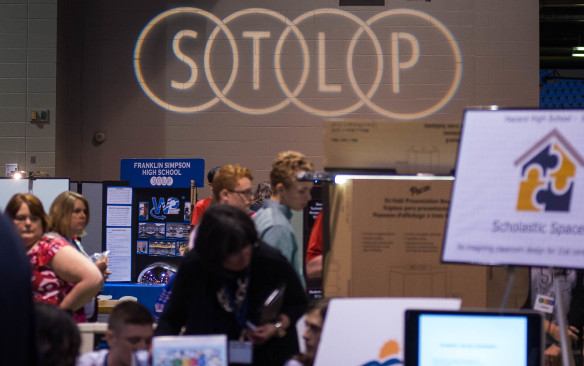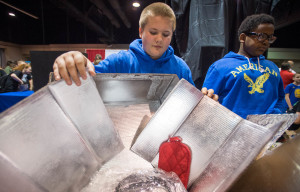
Students, parents and judges walk among the booths of projects at the STLP championships in Heritage Hall.
Photo by Bobby Ellis, April 22, 2016
By Brenna R. Kelly
Brenna.kelly@education.ky.gov
Yellow dots on back windshields all over Jessamine County, preschoolers in Pikeville ready for kindergarten, solar ovens built in Louisville but designed for Kenya, and picturesque scenes of Appalachia displayed on walls all over the state.
That’s just a fraction of the impact the more than 500 projects created this school year by Kentucky students as part of the Student Technology Leadership Program (STLP) could have in Kentucky and beyond.
But the biggest impact of the now 22-year-old program – which uses project-based learning to give students the opportunity to use and create technology to solve school and community needs – may be on the students themselves.
“I really like getting to learn new leadership skills,” said Nolan Sanchez, an 8th-grader at East Jessamine Middle School, whose STLP team created a public safety campaign. “We see these things that go on in our community and it really has an impact on us. Now we get to make a difference about them.”
More than 11,000 students, coaches and parents from across the state converged on Rupp Arena and Heritage Hall in Lexington recently for the STLP annual competition, which included 50 categories such as instructional, technical or community service projects, digital content creation and technical services.

Zane Corbin, a 7th-grader at Western Middle School for the Arts (Jefferson County), explains his school’s solar oven project at the STLP championships in Lexington.
Photo by Bobby Ellis, April 22, 2016
This year the program saw a 24 percent increase in participation, said Jeff Sebulsky, STLP program manager for the Kentucky Department of Education.
“STLP is not just an after-school club anymore. Today’s success comes from the rapid growth of STLP becoming a way for teachers to let students show what they know,” he said. “These projects grow out of identified needs or as part of classroom instruction. Seeing the best of these projects here today makes it clear that our students are creating and using technology to begin their path to college and career readiness as early as kindergarten.”
Teacher Jenny Lawyer said she didn’t even know what STLP stood for before she took over as coach for the Rich Pond Elementary (Warren County) team mid-year. But after watching her students research the dangers of texting while driving, create public safety videos and present their project to their classmates, she’s an STLP convert.
“I think it’s a very neat program for the students,” she said. “It’s teaching them skills they are going use a later on in life.”
The students had to figure out how to work as a group, solve problems and learned how to use video editing software, she said.
For Hazard High School 10th-grader Skylar Turner, STLP helped her break out of her comfort zone to and acquire skills she might not have pursued on her own.
“I’ve learned how to manage your time and money, how to manage a business and about speaking in public,” she said. “I used to want to crawl under the table, but I’m more comfortable with it now.”
Turner’s team, Photo Affects, turned scenes of Eastern Kentucky into works of art. Using pictures mostly taken by Turner, the team prints the photos on canvases and sells them to the community.
“We call (the team) ‘Affect,’ with an A, because we think our photos will affect how people see Appalachia,” she said.
The project was named one of 52 Best in Showcase winners in the competition.
In addition to the projects that covered the floor of Heritage Hall, new this year was a makerspace filled with large connecting toys, a robot that students could drive and 3-D printing pens.
Next door in Rupp Arena, students conducted live interviews with attendees that were broadcast on a large screen. On the arena floor there were competitions for Lego robots, slot car racing and sumo robots in which students programmed robots to knock each other out of a black circle.
Back in Heritage Hall, 6th-grader Mary Coleman and her team from Mullins School (Pike County) were practicing their presentation, #preschoollivesmatter, for the judges.
“We saw a problem that too many preschoolers were not ready for kindergarten,” Coleman said, adding that 54 percent of incoming kindergarteners in her district started school unprepared.
So Coleman and her team, led by 1st-grade teacher Jeanne Caudill, decided to tutor preschool students one day a week before school using a STEAM-based curriculum (science, technology, engineering, arts and math). The students used preschool friendly robots shaped like bees to help the preschooler’s learn to count, Coleman said.
“We thought that if they didn’t learn to count, how could they ever be able to add or subtract, so that’s why we did that,” she said.
The elementary students assessed the preschoolers at the beginning of the year and found that 94 percent could not count to 30. By this spring, only 12 percent could not perform that task.
“So it’s a humongous difference,” Coleman said.
Fifth-grader Jeffrey Anderson said he didn’t mind coming to school early to teach the preschoolers.
“We had fun with it, and so did the kids,” said Anderson, who wants to be a math teacher.
While many projects addressed school or local community needs, students at Western Middle School for the Arts (Jefferson County) chose to address a problem half a world away.
The students learned about refugee camps in Kenya from a translator at their school who grew up in a camp, said teacher Catha Hannah. In the camp, refugees have to find firewood so they cut nearby trees, creating a circle of deforestation.
To stop this, the Western students found a way refugees could cook without fire – a solar oven.
“This was all made of recyclable materials,” 8th-grader Treyton Helm showing off the black pot surrounded by cardboard lined with a reflective silver lining. “This was made out of a computer box we found in the computer lab.”
Helm and 7th-grader Zane Corbin both play trombone at the arts magnet school, but joined STLP because they also have an interest in technology.
“I love robotics,” Corbin said. “And I thought this would be fun because it seems like we could do a lot more for the world.”
The boys hope to send the oven to the refugee camp in order to get feedback and improve it.
East Jessamine Middle’s public safety campaign included videos, social media and yellow dots.
The students promoted the Yellow Dot Program, in which drivers put a yellow sticker on their back windshield to alert first responders that a form inside the car’s glove box contains the medical history, emergency contact information and hospital preference of the driver.
“We met with the emergency management director of Jessamine County and we saw issues that needed to be take care of in Nicholasville,” Sanchez said.
The students are also a virtual operations support team, in which they are called in to the county’s emergency operations center to coordinate social media during an emergency. The students worked at the center during several snow events last winter, tweeting and posting information to Facebook.
“We couldn’t form the words like we were kids; we had to do it very professionally,” said 8th-grader Briley Burnett.
Teacher Tracy Eckler-Adams said the students are getting valuable real-world experience.
“These guys are getting to work in the trenches with emergency responders,” she said. “When everyone else was home playing in the snow, they got activated to come in.”
MORE INFO …
Jeff Sebulsky Jeff.Sebulsky@education.ky.gov












Leave A Comment